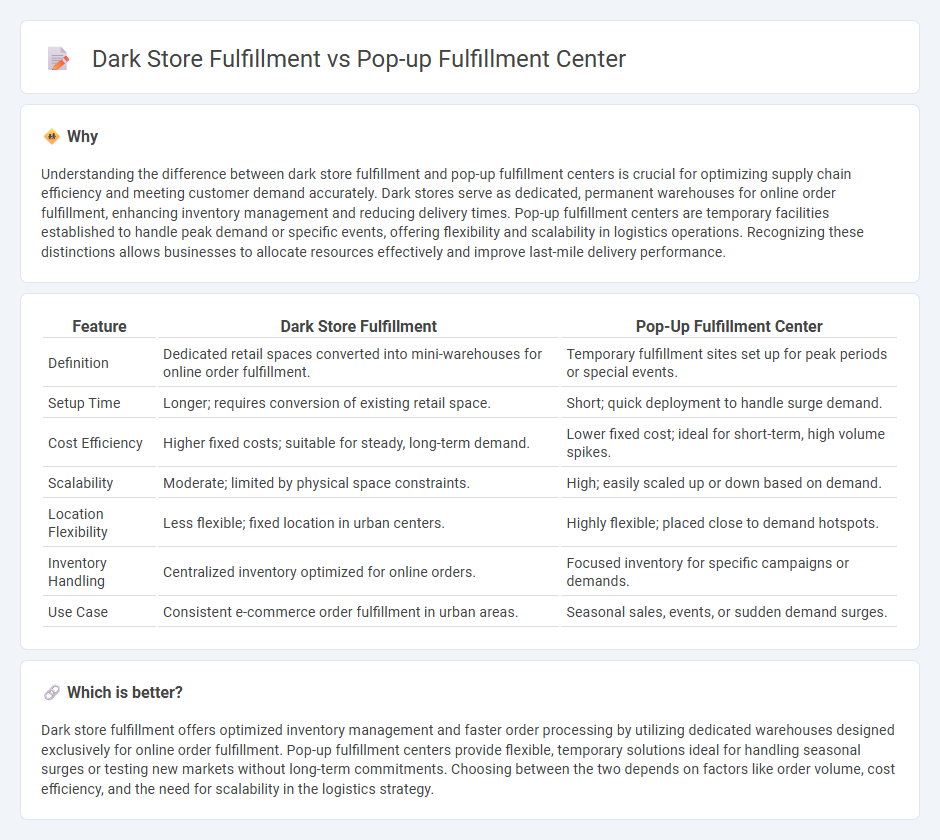
Dark store fulfillment leverages dedicated, inventory-rich locations optimized for quick order processing and delivery, enhancing efficiency in e-commerce operations. Pop-up fulfillment centers, on the other hand, are temporary, flexible hubs set up to meet surges in demand or seasonal spikes, offering scalability and local proximity advantages. Explore the key differences and benefits of these fulfillment strategies to optimize your logistics network.
Why it is important
Understanding the difference between dark store fulfillment and pop-up fulfillment centers is crucial for optimizing supply chain efficiency and meeting customer demand accurately. Dark stores serve as dedicated, permanent warehouses for online order fulfillment, enhancing inventory management and reducing delivery times. Pop-up fulfillment centers are temporary facilities established to handle peak demand or specific events, offering flexibility and scalability in logistics operations. Recognizing these distinctions allows businesses to allocate resources effectively and improve last-mile delivery performance.
Comparison Table
| Feature | Dark Store Fulfillment | Pop-Up Fulfillment Center |
|---|---|---|
| Definition | Dedicated retail spaces converted into mini-warehouses for online order fulfillment. | Temporary fulfillment sites set up for peak periods or special events. |
| Setup Time | Longer; requires conversion of existing retail space. | Short; quick deployment to handle surge demand. |
| Cost Efficiency | Higher fixed costs; suitable for steady, long-term demand. | Lower fixed cost; ideal for short-term, high volume spikes. |
| Scalability | Moderate; limited by physical space constraints. | High; easily scaled up or down based on demand. |
| Location Flexibility | Less flexible; fixed location in urban centers. | Highly flexible; placed close to demand hotspots. |
| Inventory Handling | Centralized inventory optimized for online orders. | Focused inventory for specific campaigns or demands. |
| Use Case | Consistent e-commerce order fulfillment in urban areas. | Seasonal sales, events, or sudden demand surges. |
Which is better?
Dark store fulfillment offers optimized inventory management and faster order processing by utilizing dedicated warehouses designed exclusively for online order fulfillment. Pop-up fulfillment centers provide flexible, temporary solutions ideal for handling seasonal surges or testing new markets without long-term commitments. Choosing between the two depends on factors like order volume, cost efficiency, and the need for scalability in the logistics strategy.
Connection
Dark store fulfillment and pop-up fulfillment centers are connected through their shared focus on optimizing last-mile delivery and improving urban logistics efficiency. Both models use strategically located, non-traditional retail spaces to enable faster order processing and reduce delivery times in high-demand areas. This connection enhances supply chain agility by leveraging compact, flexible facilities tailored for rapid e-commerce fulfillment.
Key Terms
**Pop-up Fulfillment Center:**
Pop-up fulfillment centers are temporary storage and distribution hubs designed to quickly address seasonal spikes and regional demand, enhancing last-mile delivery speed and customer satisfaction. These centers leverage flexible locations and scalable operations, reducing shipping costs and enabling retailers to adapt rapidly to market fluctuations. Discover how integrating pop-up fulfillment centers can optimize your supply chain efficiency and boost e-commerce performance.
Temporary Warehouse
Temporary warehouses serve as flexible fulfillment hubs that can be rapidly deployed to meet fluctuating demand in pop-up fulfillment centers, offering scalable storage and processing capabilities. Dark store fulfillment relies on permanent, retail-like facilities optimized exclusively for online order preparation and distribution, ensuring faster delivery times and inventory accuracy. Explore the strategic advantages and operational differences between these models to optimize your supply chain.
Seasonal Demand
Pop-up fulfillment centers rapidly scale inventory and order processing during peak seasonal demand, minimizing shipping distances and reducing last-mile delivery costs. Dark store fulfillment leverages permanent retail spaces converted into localized warehouses, optimizing stock availability and enabling faster fulfillment within urban areas. Explore the strategic benefits of each model to enhance your seasonal supply chain efficiency.
Source and External Links
Pop-Up Distribution Centers Overcome Last-Mile Delivery Obstacles Amid COVID-19 - Pop-up fulfillment centers (or micro-fulfillment centers) are temporary, flexible facilities that bring inventory closer to customers to speed up delivery, reduce fulfillment time, and adapt quickly to increased demand, especially important during peak seasons or crises like COVID-19.
Pop-up Distribution Centers - These centers can be set up for short or extended periods from small store locations to large 3PL warehouses, helping retailers spread inventory, reduce shipping times, and meet customer expectations for fast delivery with cloud-based automation technology aiding operations.
Creating a "Pop-Up Distribution Center" In Your Warehouse - Pop-up distribution centers inside existing warehouses create temporary, scalable spaces with dedicated shipping and fulfillment tools to speed order processing, reduce handling time, and support peak demand without needing additional facilities.
 dowidth.com
dowidth.com